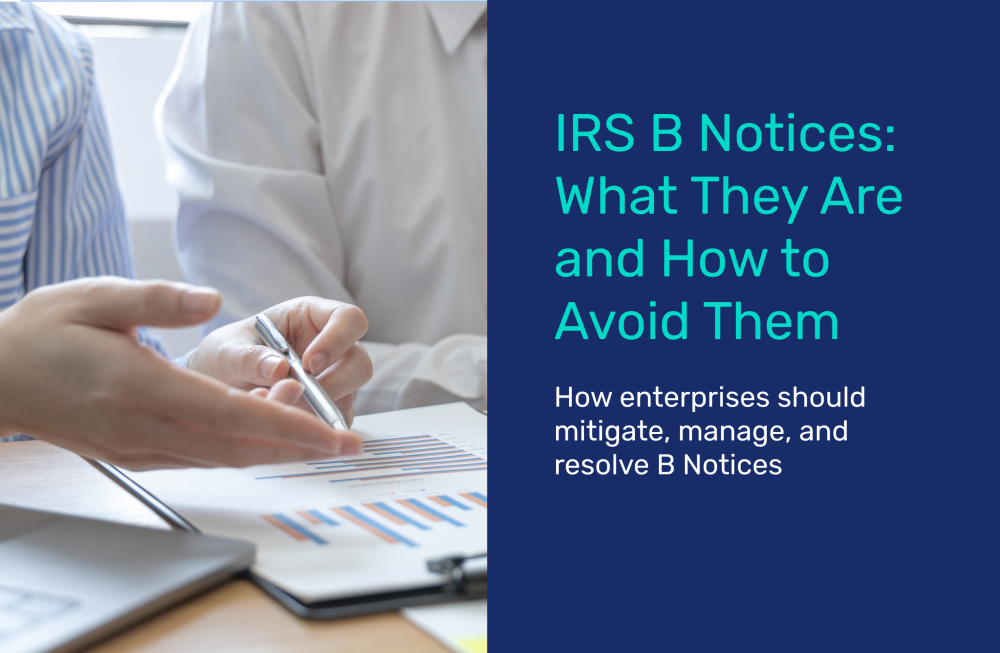IRS B Notices: What They Are and How to Avoid Them
How enterprises should mitigate, manage, and resolve B Notices (i.e. CP2100 or 972CG)

Published on:

Any U.S. operating business that facilitates a wide array of payment types to individuals or other businesses is likely subject to filing U.S. information returns (i.e., 1099’s). As a filer of Forms 1099, it is also likely that a “B Notice” has been received from the IRS alerting that the Forms 1099 filed have errors with the names and taxpayer identification numbers (TINs) reported.
What is a B Notice (i.e., CP2100 or 972CG)?
A “B” notice is a backup withholding notice and is sent to a filer of Forms 1099. When a Form 1099 is filed, the IRS undergoes a process to match the recipient name and TIN information listed on the Form 1099 they receive with the IRS database.
The IRS relies on this matching process to maintain the integrity of the self-reporting aspect of the US income tax system. When a name and TIN combination doesn’t match the IRS database, the IRS can’t reconcile the income reported with an individual or non-exempt entity’s US tax return.
Each filing may represent lost tax revenue—or, at minimum, the tax revenue the IRS can’t track if it isn’t included on a tax return.
To resolve this issue, the IRS has taken three key steps, all of which result in the actual B Notice:
Built a process around identifying mismatches
Created procedures for filers to resolve issues
Applied significant penalties for noncompliance
What is required if a B Notice is received?
It is imperative to follow the required actions as outlined in IRS Publication 1281 here, as companies that follow the prescribed procedures should not have to pay the fines in the actual penalty notice 972CG.
Here is a key overview of the process for handling B Notices:
The notices are typically sent in September or October, with a second-pass B Notice issued in March of the following year for late or corrected filings.
Upon receiving a B Notice, enterprises must search for accounts listed on the B Notice.
Determine the appropriate withholding, solicitation, or account updates based on the account records and details listed in Question 14 of Publication 1281.
Specifically, for accounts that match the B Notice, notify the account holder within 15 business days of receiving the notice (or from the date listed on the notice) and request a Form W-9.
Begin back-up withholding at a rate of 24% on all future payments no later than 30 days after receiving the B Notice, keeping in mind that if the certified TIN (i.e., Form W-9) is received, it will alleviate the need for backup withholding.
Additional complexities of B Notice resolution
One of the most important nuances of B Notices is distinguishing between the first and second notices that a filer receives (the IRS notice does not distinguish between them) – as each requires different actions.
First B Notice: A first B Notice refers to a combination of a name and TIN that hasn't been recognized in any B Notice obtained within the preceding three calendar years by the filer. Those who are indicated in a first B Notice are required to fill out a valid Form W-9 to prevent backup withholding.
Second B Notice: If two B Notices have identified a mismatched taxpayer identifier within three calendar years, backup withholding can no longer be remedied by filling out Form W-9. In this case, an enterprise needs to collect a social security number or IRS confirmation letter for entities to stop further backup withholding.
Meeting the above timelines and requirements can help enterprises avoid fines of $270 per mismatched taxpayer identifier.
To reduce B Notices, organizations should implement key compliance procedures and products
At scale, B Notice mitigation and resolution can quickly overwhelm even the most efficient enterprises – and payment withholdings for inaccuracies can be extremely frustrating for customers. Forward-looking enterprises require an automated and innovative solution for not only managing customer data but also automating the B Notice process and requirements.
As an integral onboarding procedure, enterprises should collect taxpayer information (via Form W-9 as a best practice) and validate customer TINs with the IRS TIN matching system. This will help dramatically reduce the number of accounts subject to a B Notice.
Long-term business success requires adapting to regulatory needs, and tax information reporting is a compliance cornerstone. From Form W9 to the 1099, 1099INT, and all B Notice management, TaxBit’s end-to-end platform helps industry leaders solve compliance complexity.

